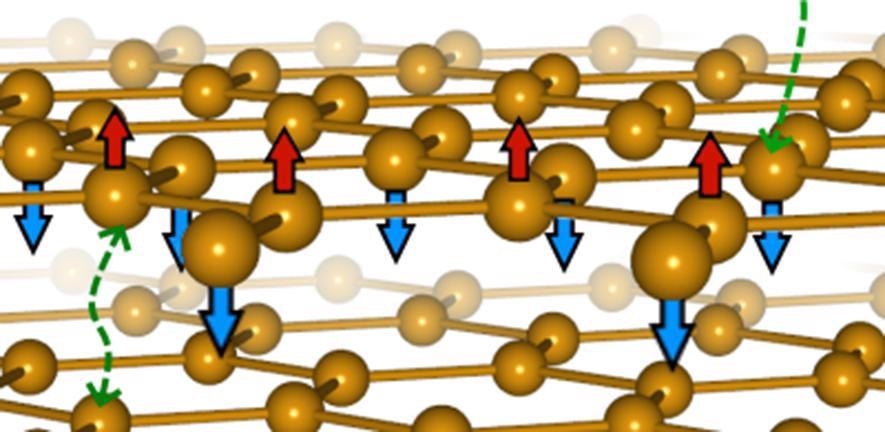AZoNano speaks with Dr. Matthew Coak from the University of Warwick and the University of Cambridge, leader of an international team that has identified a new form of magnetism in so-called magnetic graphene - this could lead to new ways of understanding superconductivity in this unusual type of material.
Can you give our readers a summary of your recent research?
We have measured the magnetic properties of a layered material under extreme conditions of pressure. We carried out the first high-pressure neutron diffraction study on the TMPS3 family of van-der-Waals materials (TM = a transition-metal), compounds currently under intense research scrutiny worldwide.
These are layered honeycomb antiferromagnetic insulators, long studied as near-ideal 2D magnetic systems with a rich landscape of competing magnetic interactions and a variety of magnetism across the family. We use pressure, generated by compressing liquids in between opposed anvils which can then be cooled to low temperatures, to tune these 2D materials towards becoming normal 3D systems by pressing their crystal planes together – like turning graphene back into graphite… or diamond eventually?
Our previous work has identified structural changes and a crossover from insulating to metallic conduction in FePS3 as pressure is applied – this new breakthrough is to bring understanding of what happens to the magnetism as the crystal structure evolves and becomes more 3D, and in particular when the material becomes metallic. Magnetism in an insulator comes from localized electrons clamped to individual atoms in the crystal, and how these interact – when such a material becomes a metal and electrons are suddenly free to roam, you certainly expect big changes in the magnetism.
We wanted to understand exactly what happens in FePS3. Unfortunately, when we looked at this problem and how to answer this question, there simply was no way to perform this measurement with the existing experimental technology – we had to draw together a team of experts from all over the world (UK, Korea, France, Uzbekistan, Russia, US, Czech Republic, Vietnam) to push the boundaries of what was achievable and make the measurements possible so that we could answer the physics questions we had.

Image Credit: The University of Cambridge
What were the experimental techniques involved in the research?
We had previously explored the crystalline structure, the interaction with light, and the electrical conduction properties of FePS3 – the elephant remaining in the room was the magnetism. We had not measured this because it simply was not possible! You can measure basic magnetic properties in the lab using a magnetometer, but for antiferromagnets with small magnetic moments like FePS3 and thus minute signals detection is very difficult.
Combine that with the signal from the body of a pressure cell, and these measurements become insurmountable. Even then, the maximum pressure achievable by the existing lab-based methods is only a fraction of what is needed to observe the evolution across a wide pressure regime.
So we turned to a non-lab based option and the most powerful tool to examine magnetism, which is neutron scattering – bouncing neutrons from a nuclear reactor off your material, their angle of deflection controlled by the arrangement of magnetic moments within it. As neutrons only interact weakly with matter, you need a lot of them – and a lot of sample. This makes high-pressure generation yet again difficult, as pressure = force/area and we need to make area large – so we have to use a 200 Ton press (which terrifies me for one!) to generate the loads needed.
We used a new design of pressure cell with anvils made of sintered diamond and machined into a very precise double-toroidal shape to generate pressures of 20 GPa – twice that previously achievable, in experiments at the Institut Laue Langevin (ILL) Neutron Source in Grenoble, France.
What are the key differences between magnetic graphene and traditional graphene?
What we are wistfully calling 'magnetic graphene' is certainly not actually graphene! Graphene is a sheet of purely carbon atoms in honeycomb layers, FePS3 and related compounds are honeycombs of metal atoms with phosphorus and sulphur clusters between them spacing out the layers.
The magnetism is from the metal sites – and changing the metal for another, such as nickel or manganese, drastically alters the magnetic behavior, giving us a nice playground for fundamental magnetism physics and for looking for applications in tech. What they have in common, however, is that in both cases, atoms are organized in a honeycomb fashion and they can be peeled into single layers of atoms.
Graphene is a very exciting material and is rightly seeing a lot of attention right now. What it and other much-studied 2D materials are lacking is magnetism. How does adding magnetism, a very complex and rich phenomenon, into these low-dimensional systems, change their behavior? What does magnetism really look like in a 2D material? And what kind of exciting new technology can we build with these 'magnetic graphenes'?
They can be peeled apart to single atomic layers with simple sticky tape like graphene and then stacked and combined together to form exotic composite materials and exciting new alternatives to silicon chip electronics.
What benefits are the findings likely to have for the computing field?
Advances in computing hardware for a long time now have boiled down to making the features on silicon chips smaller and smaller – but we are getting close to hard limits set by the simple size of the silicon atoms themselves, the quantum limit.
New quantum technologies and devices are needed to meet the emerging challenges of conventional electronics reaching their limits and a drive for more energy-efficient alternatives. 2D materials provide a promising candidate, through novel transistor designs and spintronics, which uses currents of magnetism instead of electricity to transfer information. To design and use these systems at an application level, it is essential that the underlying physics, including both the limitations and possibilities intrinsic to the materials, are fundamentally understood and tested, and routes to synthesizing new designer materials uncovered.
At what stage did the team employ neutrons in this research?
Neutrons were the tool we used to 'image' the magnetism throughout. This work is almost entirely a report of a collection of neutron-scattering experiments.
Could you tell our readers more about the previous discovery that FePS3 can become a metal under high pressure?
This was a fascinating discovery – we showed that the material switching to becoming a metal was concurrent with it switching to becoming 3D – i.e., there were no longer big empty spaces between its layers of atoms. This is precisely the kind of control and tuning over dimensionality we seek to achieve with our high-pressure techniques.
Who is the team behind the research and what's next for you?
I am most proud of this work because it represents an assembly of a worldwide team of experts in their technique or field, to tackle a seemingly insurmountable problem. The team goes far beyond Cambridge (I for one am based at Warwick), to France, Russia, the USA, Uzbekistan, South Korea and beyond.
For our plans – now that we have unlocked and enabled these measurement techniques, they can become routine and accessible for all users at the ILL. That is what is really exciting to me – there will be so much science that is now doable with these pressures achievable. I have so much respect and gratitude for the Sample Environment Team at the ILL, along with Thomas Hansen and Stefan Klotz, the high-pressure neutron experts in the team. They did the real drity work to make this happen – I just assembled the team and led the science and analysis. Immediately for us, there remain many more compounds in the TMPS3 family we are keen to investigate, and we want to draw in on the superconductivity question.
Where can readers find more information?
Here are some links where readers can find more information:
https://www.ill.eu/news-press-events/news/high-pressure-neutron-studies-reveal-evolution-of-magnetism-through-an-insulator-to-metal-transition
https://www.phy.cam.ac.uk/news/2018spinning-graphene2019-a-case-of-magnetic-layers
https://www.cam.ac.uk/research/news/magnetic-graphene-forms-a-new-kind-of-magnetism
About Dr. Matthew Coak
 I am a Postdoctoral Research Fellow at the University of Warwick, and Visiting Scientist at the University of Cambridge, doing fundamental research in condensed matter physics. I use extremes of pressure, magnetic fields and low temperatures to tune and study low-dimensional magnetic materials and superconductors. I completed my undergraduate degree in physics at the University of Oxford, and my Ph.D. at the University of Cambridge in 2017.
I am a Postdoctoral Research Fellow at the University of Warwick, and Visiting Scientist at the University of Cambridge, doing fundamental research in condensed matter physics. I use extremes of pressure, magnetic fields and low temperatures to tune and study low-dimensional magnetic materials and superconductors. I completed my undergraduate degree in physics at the University of Oxford, and my Ph.D. at the University of Cambridge in 2017.
My specialization was in the use of high pressure to tune quantum criticality in ferroelectric systems and Mott transitions in 2D insulating antiferromagnetic. My first postdoctoral position was in the Emergent Phenomena Group of the IBS Centre for Correlated Electron Systems at Seoul National University, under Prof Je-Geun Park. Here I headed the van-der-Waals materials team and continued my investigation into Mott transitions and the tuning of low-dimensional magnetism with pressure, including synchrotron and neutron scattering studies.
I then joined the Superconductivity and Magnetism group at Warwick in March 2019. I was very grateful to be named as one of the Institute of Physics' Emerging Leaders 2019 - "the most exciting researchers of their generation, with the potential to revolutionize their fields".
My current work focuses on the tuning of low-dimensional quantum magnet systems and materials which exhibit unconventional superconductivity through hydrostatic pressure, low temperatures, and ultra-high magnetic fields. I am motivated by the search for new multifunctional materials and combinations of materials for energy saving and computing breakthroughs through a fundamental understanding of the underlying physics.
Disclaimer: The views expressed here are those of the interviewee and do not necessarily represent the views of AZoM.com Limited (T/A) AZoNetwork, the owner and operator of this website. This disclaimer forms part of the Terms and Conditions of use of this website.